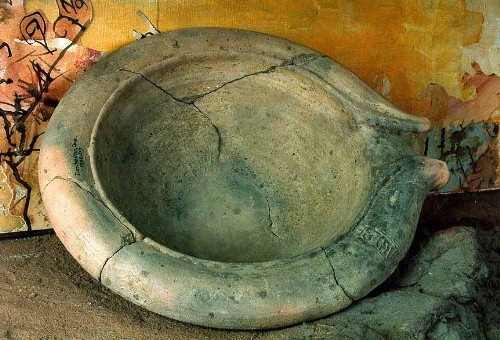|
|
Oxford Ware Mortarium from Headington, Oxford: 2nd century AD |

Pounding and crushing was part of the initial preparation of many ingredients in Roman cooking, and Roman recipe books mention the use of a vessel called mortaria. Mortaria were heavy earthenware bowls with a sturdy flange for keeping a grip, with sandy grit sprinkled into the base before firing to help in breaking up solid food, and a wide channel in the rim for pouring off liquid. Two favourite Roman foods, sausages and sauces, would have been made using a mortarium, which was the Roman equivalent of a food processor today.
Mortaria made of Oxford Ware are easily recognisable by the specialist because of the highly distinctive, rounded, multi-coloured translucent bits of the stone called quartzite with which the clay was gritted. These derive from the local gravels. The form of this mortar is typical of the 2nd century, when many potters stamped their wares with a name-stamp, as a result of which we know the names of over 200 potters operating in Roman Britain.
Oxford mortaria were some of the earliest Oxford wares to travel out of the immediate area, and are found already in the 2nd century in some of the larger Romano-British towns.
Apicius, the author of the only surviving Roman cookery-book, quotes a recipe for Prawn Rissoles for which the mortarium was essential:
‘The prawns are taken out of their shells and pounded in a mortar with pepper and best liquamen (salty fish sauce) and rissoles formed from the meat.’ Setúbal in Portugal was one of the main centres of the liquamen (or garum) export industry.
© 1998 Oxfordshire Museum Service, Setúbal Museums and the Benaki Museum